5G commonly used terminology
AAS (Active Antenna System), an active antenna system, can be seen as a combination of RRU and antenna, which integrates an active radio frequency transceiver unit and a passive antenna array.
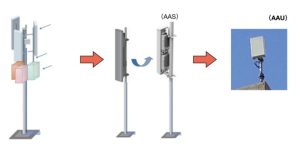
In the past, the RRU and the antenna were separated, and the two were connected through a radio frequency feeder. After integrating the RF transceiver unit and antenna array, AAS can support Massive MIMO technology, which can reduce RF feeder loss, increase network coverage and capacity, and reduce sky space and maintenance workload.
AF (Application Function), application function. AF is similar to an application server, which interacts with other 5G core network control plane NFs and provides business services. AF can exist for different application services, and can be owned by an operator or a trusted third party.
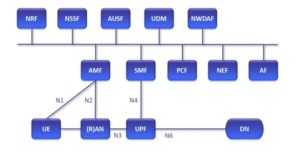
AMF (Access and Mobility Management Function), access and mobility management function. AMF is responsible for functions such as UE identity verification, authentication, registration, mobility management, and connection management. Compared with 4G EPC, the function of AMF is similar to that of MME.
AUSF (Authentication server function), the authentication server function, is responsible for authentication and authentication.
Backhaul, backhaul, refers to the transmission network that connects the radio access network (RAN) and the mobile core network. Under the distributed RAN (D-RAN) architecture, backhaul connects the base station to the core network; under the centralized RAN (C-RAN) architecture, it connects the centrally deployed cloud BBU/DU pool to the core network.
BBU (Baseband Unit) refers to the unit responsible for processing baseband signals in the base station system.
Beamforming, beam forming. Radio waves are like waves. When they collide (interfere) with each other, they become stronger or weaker, depending on how they collide. Beamforming takes advantage of this feature. It transmits the same signal through multiple antenna units, and adjusts the phase and amplitude of each antenna unit, so that radio waves are enhanced in a specific direction, and they cancel each other out and weaken in other directions. Make wireless signal propagation more concentrated like beams, which can increase coverage and reduce interference.
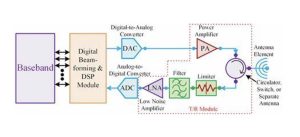
CA (Carrier Aggregation), carrier aggregation, is to aggregate two or more carriers (channels) to provide users with a higher data rate. CA is like merging two or more roads together to make the road wider.
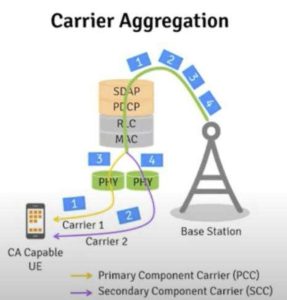
Control Plane, the control plane, is mainly responsible for processing non-data packet forwarding, including control signaling such as mobility management, connection establishment, and quality of service (QoS).
C-RAN (Centralized/Cloud-Radio Access Network), centralized/cloud-based radio access network), C stands for Centralized, Cloud, Clean and Cooperative, and refers to the centralized and cloud-based/virtualized deployment of CU and DU , Which can improve the coordinated scheduling between cells, achieve more flexible resource scheduling and load balancing, and reduce deployment and operation and maintenance costs.
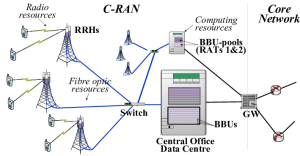
CU (Centralized Unit), the central unit. 4G base station equipment is composed of BBU (baseband unit) and RRU (remote radio unit). The RRU is usually extended to a place close to the antenna. The BBU and the RRU are connected by optical fiber, and the RRU and the antenna are connected by a feeder. The 5G base station equipment divides the BBU into CU (Central Unit) and DU (Distributed Unit), and is connected to AAU (Active Antenna Unit) through optical fiber. The CU is responsible for hosting the RRC (Radio Resource Control Layer), SDAP (Service Data Adaptation Protocol) and PDCP (Packet Data Convergence Protocol Layer) sublayers of the 5G base station, which centrally controls one or more DU units.
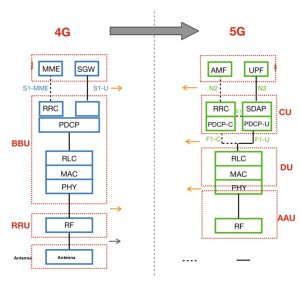
CUPS (Control and User Plane Split), the separation of control plane and user plane functions, refers to the separation of the control plane functions responsible for connection management, QoS policies, user authentication and other functions from the user plane functions responsible for data traffic forwarding to simplify and unify The entire network architecture makes the core network more flexible and efficient. Under the CUPS architecture, as the number of traffic increases, user plane functions can be independently expanded without affecting the control plane, and it is also convenient for centralized management of the control plane.
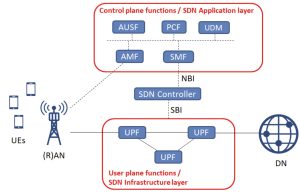
DN (Data Network) refers to a network that provides data-centric services such as the Internet, cloud/OTT services, and enterprise networks.
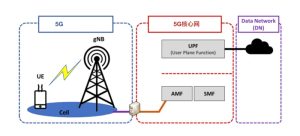
D-RAN (Distributed Radio Access Network), a distributed radio access network. Compared with the C-RAN architecture, D-RAN is a traditional RAN architecture, which installs BBUs and RUs on distributed sites.
DSS (Dynamic Spectrum Sharing), dynamic spectrum sharing, refers to 5G NR and 4G wireless sharing the same spectrum resources, and dynamic allocation of time-frequency resources to 4G and 5G users, usually by sharing the currently used 4G middle and low frequency bands to achieve 5G NR is introduced into the 4G coverage area, so that 5G wide coverage can be realized at low cost and quickly.
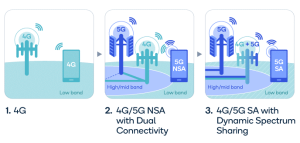
DU (Distributed Unit), a distributed unit, hosts the nodes of the RLC, MAC, and PHY sublayers of the 5G base station, and is mainly responsible for the MAC layer functions and some physical layer functions that deal with real-time requirements.
eCPRI (Enhanced Common Public Radio Interface), an enhanced common public radio interface, is a fronthaul interface protocol used to connect wireless base stations BBU/DU and AAU. Compared with CPRI in the 4G era, eCPRI’s data transmission method supports Ethernet technology, supports physical layer function splitting, extends the fronthaul bandwidth by 10 times, and greatly improves the efficiency and flexibility of the fronthaul.
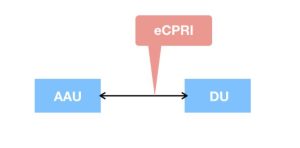
Edge Cloud refers to the deployment of cloud at the edge of the network to bring computing power and applications closer to users, which can greatly reduce network delay and backhaul burden, bring users a more extreme business experience, and promote more Many application innovations.
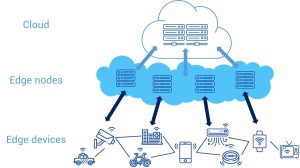
EPC (Evolved Packet Core), evolved packet core network, 4G LTE core network.
eMBB (Enhanced Mobile Broadband) is one of the three scenarios of enhanced mobile broadband and 5G. It is the first and most extensive scenario of 5G. It means that 5G can provide a better mobile broadband experience than previous mobile communication standards and technologies. The peak rate and average data rate are increased by more than 10 times.
en-gNB, gNB is the 5G base station. In the option 3 deployment mode, the 5G base station is anchored to the 4G base station and the 4G core network EPC. At this time, the 5G base station is called en-gNB.
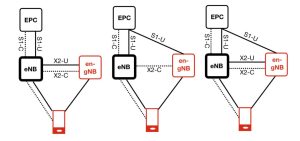
The dual connection between EN-DC, E-UTRA (LTE) and 5G NR means that the UE is connected to both LTE and NR wireless technologies at the same time, and it also refers to the option 3 deployment mode.
FlexE (Flexible Ethernet), a standard defined by the Optical Interconnection Forum (OIF) in 2016, introduces the FlexE Shim layer on the basis of standard Ethernet, and realizes the decoupling of the MAC and PHY layers. Realize flexible rate adaptation, expand network capacity by bundling multiple physical links to meet the large bandwidth requirements of 5G, and support multiple services through the Shim layer time slot configuration to achieve physical isolation between multiple services . For end-to-end 5G network slicing, FlexE is a key technology that can implement network hard slicing on the basis of shared network infrastructure and achieve business isolation.
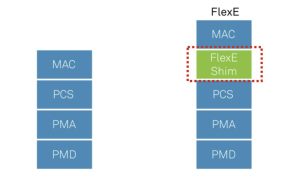
FR1 (Frequency range 1), one of the two frequency ranges specified by 5G NR, FR1 refers to the sub-6GHz frequency band, covering the range between 410 MHz and 7125 MHz.
FR2 (Frequency range 2), one of the two frequency ranges specified by 5G NR, FR2 includes the millimeter wave frequency band between 24.25 GHz and 52.6 GHz. Fronthaul, fronthaul, refers to the transmission network where RU connects to DU in the C-RAN architecture.
FWA (Fixed Wireless Access) refers to the large bandwidth capability based on 5G NR, which uses 5G wireless access to replace the last mile of fiber to the home, thereby eliminating the need for fiber laying and providing low-cost and flexible broadband access for enterprises and families service.
gNB (gNodeB), the full name of next Generation Node B, is the naming of 5G base stations.
Hard Slicing refers to the allocation of network resources to different customers or applications in a completely isolated manner based on 5G software and cloud architecture (network slicing).
IMT-Advanced (International Mobile Telecommunications-Advanced), the ITU’s 4G and 4.5G nomenclature, refers to mobile systems that exceed the capabilities of IMT-2000 (3G).
IMT-2020 (International Mobile Telecommunications-2020), the ITU’s 5G naming, aims to study IMT in 2020 and beyond.
Low Band, low frequency band, usually refers to the frequency band less than 1GHz. It is currently mainly used for 3G and 4G. It has the characteristics of long coverage distance and strong wall penetration capability. However, the low frequency band has a small bandwidth and a small data capacity that can be carried.
LTE (Long-Term Evolution), long-term evolution, refers to the 4G mobile communication standard. The network data rate of LTE is 10 times faster than that of 3G.
LTE-A (Long-Term Evolution-Advanced) refers to further enhancements to the LTE standard. In order to meet the requirements of IMT-Advanced, LTE-A was formally submitted to ITU-T at the end of 2009 and released as a 3GPP standard in 3GPP Release in 2011 10
Massive MIMO refers to the realization of three-dimensional precise beamforming and multi-stream multi-user multiplexing by integrating a large number of antenna units and more radio frequency channels on the base station side, thereby improving coverage and capacity, and reducing interference.
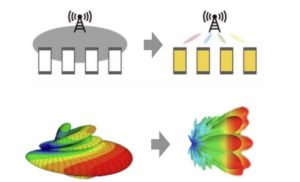
MEC (Multi-Access Edge Computing), refers to cloud computing at the edge of the network. It deploys computing power closer to users, which can reduce network latency and provide users with computing power and applications nearby. This can greatly enhance the business experience.
Mid-Band, the mid-band, usually refers to the frequency band between 1GHz and 6GHz. It is located between the low frequency band and the millimeter wave frequency band. It has both coverage and bandwidth capabilities and is regarded as a key frequency band for 5G.
Midhaul, midhaul, refers to the transmission network between CU and DU.
MIMO (Multiple-Input Multiple-Output) refers to increasing the data transmission rate by using multiple antennas to simultaneously send and receive multiple data streams on the same channel.
mmWave, millimeter wave, a high frequency band between microwave and infrared, can provide large-capacity, high-speed 5G services, but the coverage and wall penetration capabilities are weak.
MTC (Machine Type Communications), machine type communication, refers to the communication between machines (things).
mMTC (Massive Machine-Type Communications), one of the three major 5G application scenarios, refers to large-scale machines (things) in a characteristic area that communicate through application servers that reside on the core network.
MU-MIMO (Multiple user, multiple-input / multiple-output), multi-user MIMO, refers to the simultaneous transmission of multiple data streams spatially multiplexed to multiple users, which can double the capacity of the cell.
NEF (Network Exposure Function), a network opening function, is a network functional entity responsible for opening 5G core network capabilities to third parties or non-3GPP environments. You can treat it as a proxy, conversion point, or API aggregation point. For example, in edge applications, MEC (AF) needs to request PCF to offload traffic to the local server through NEF.
Network Slicing, network slicing, refers to the SLA requirements for network bandwidth, delay, security, reliability, geographic coverage, etc., from the end-to-end network infrastructure on-demand to “slicing” multiple interactions from the end-to-end network infrastructure according to different industry customers or applications. Isolated, secure, and SLA-guaranteed logical network.
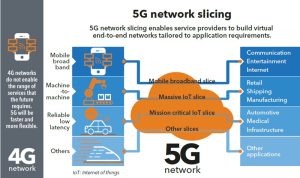
NGC (Next Generation Core), the next generation core network, refers to the 5G core network.
ng-eNB, similar to en-gNB, in option 7, option 5, and option 4 modes, eNB (4G base station) connects to the 5G core network through the NG interface, which is called ng-eNB.
NR (New Radio), New Radio, refers to the 3GPP 5G wireless system.
NRF (Network repository function), network repository function, is responsible for network function service registration, status monitoring, etc., realizes automatic management, selection and scalability of network function services, and allows each network function to discover the services provided by other network functions.
NSA (5G Non-Standalone Architecture), non-independent networking, refers to the use of dual connectivity, anchoring the 5G NR control plane to 4G LTE, and using the old 4G core network EPC. NSA is the early deployment architecture of 5G, which aims to use the existing 4G infrastructure to rapidly expand the 5G network.
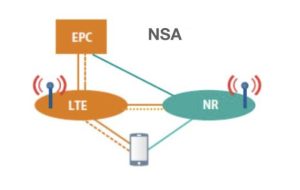
NSSF (Network slice selection function), network slice selection function, manages network slice related information, for example, is responsible for selecting network slices for the terminal and determining which AMF to use.
PCF (Policy Control Function), policy control function, is responsible for the 5G core network control plane function of policy control. Simply put, it mainly manages the QoS of each service data flow in the 5G core network.
P-GW (Packet Data Network Gateway), a packet gateway, is responsible for managing the QoS and bandwidth parameters in the LTE network, and acts as an IP router to connect the 4G core network to the external Internet. This function is replaced by UPF in the 5G core network.
Private 5G, 5G private network, refers to the enterprise or industry wireless private network constructed using the 3GPP 5G standard. The 3GPP standard defines two 5G private network deployment modes: SNPN (independent non-public network) and PNI-NPN (public network integrated NPN). PNI-NPN is what we often say “private public network”, which means that enterprises can share RAN with operators’ 5G public network, or share RAN and core network control plane, or share 5G public network end-to-end (end-to-end network 5G private network is deployed in a slicing method; SNPN is what we often call the “independent deployment mode”, which refers to the independent deployment of the entire 5G network from the base station to the core network to the cloud platform, which can be isolated from the operator’s 5G public network.
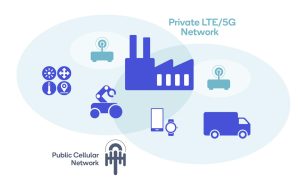
QoE (Quality of experience), the quality of experience, measures the overall satisfaction of customers with the network.
QoS (Quality of service), the quality of service, measures network capabilities such as delay, bit error rate, and uptime.
RAN (Radio Access Network), wireless access network.
RU (Radio Unit), a wireless unit, is responsible for converting the digital signal from the DU into a radio frequency signal and transmitting it to the antenna, and converting the radio frequency signal from the antenna into a digital signal and transmitting it to the DU.
SA (5G Standalone Architecture), 5G independent networking architecture, refers to 5G NR directly connected to the 5G core network (NG Core), no longer dependent on 4G, is a complete and independent 5G network
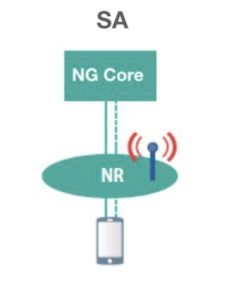
SBA (Service-based architecture), service-based architecture. The 5GC control plane introduces a service-based architecture (SBA). In SBA, each NF is not a one-to-one (point-to-point) connection, but all NFs use the same protocol (HTTP/2) and share a communication channel. Each NF can communicate with any NF, and the connection between NFs It is more flexible and greatly enhanced flexible scalability.
SMF (Session management function), session management function, is responsible for establishing and managing sessions, UE IP address allocation and management, etc.
Small Cell, small cell, micro cell, refers to a cellular wireless access point that works in a low-power mode, and usually provides services for a small number of users in a small area. It can work in licensed or unlicensed spectrum.
SR (Segment Routing), segment routing, is a source routing technology that forwards data packets according to a dynamically defined path at the source node. SR supports two data forwarding planes, MPLS and IPv6.
S-GW (Serving Gateway), serving gateway, is mainly responsible for data packet transmission between eNB and P-GW. In the 5G core network, S-GW is replaced by UPF.
Soft Slicing, soft slicing, refers to the dynamic allocation of network resources for different services based on QoS technology.
TSN (Time Sensitive Networking), time sensitive network. Traditional Ethernet technology can only achieve “best effort” communication, and cannot meet the high reliability and low latency requirements of industrial manufacturing applications. For industrial automation, it is necessary to upgrade the traditional “best effort” Ethernet to provide “determinism” “service. At the same time, there are many existing industrial protocols that are isolated from each other, and various protocols use different “language”, which increases the difficulty of integration and the cost of operation and maintenance. It is under this background that TSN came into being. It is defined by IEEE standards, which can provide deterministic services based on standard Ethernet technology and provide standardized, unified and economical solutions. The 5G system is integrated with the TSN network. Based on the low-latency and high-reliability capabilities of 5G uRLLC, it can meet the four stringent functional requirements of the TSN architecture: time synchronization, low-latency transmission, high reliability and resource management, so as to satisfy the factory Industrial Internet use cases such as automation and power grid distribution automation.
UDM (Unified Data Management), unified data management, where all user data, network service configuration files, network access policies and other information are stored. For example, when a user initially connects to the network, the user information is verified through the data in UDM.
URLLC (Ultra-Reliable Low-Latency Communications), ultra-reliable and ultra-low-latency communications, one of the three major scenarios of 5G, aims to support services that are highly sensitive to delay and stability, and can be guaranteed by network slicing technology.
UPF (User Plane Function), the user plane function, is responsible for forwarding traffic between the wireless access network and Internet/DN, reporting traffic usage, QoS policy implementation, etc., corresponding to the user plane of S/PGW in 4G EPC.
V2X (Vehicle-to-everything), the Internet of Vehicles, aims to connect cars to the Internet, and to connect cars to cars, cars to people, cars and road infrastructure to realize the exchange of information between cars and the outside world, including Connectivity between V2N (vehicle and network/cloud), V2V (vehicle and vehicle), V2I (vehicle and road infrastructure), and V2P (vehicle and pedestrian).



